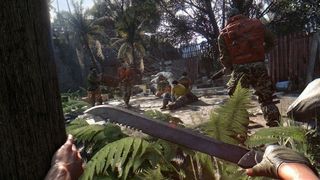
Written by Matt Cabral
“After a couple years, all games will have this freedom.” begins Maciej Binkowski, lead designer on Dying Light . The Techland developer—who also held design and production positions on the studio's previous zombie-pummeling romp, Dead Island —is referring to his forthcoming game's focus on freedom of movement.
Just as the ability to jump in first-person shooters became pretty standard after Duke Nukem proved players needn't be rooted to the floor, Binkowski believes free-running in the FPS space could be the genre's “next step in evolution.” Citing that similar experiences currently don't allow gamers to clear walls that “their grandmas could jump”, he's pretty confident Dying Light's offering an unprecedented way for players to navigate the zombie apocalypse.
I got to do some running, jumping, and climbing during a hands-on session at last year's E3, but the controls occasionally yielded more frustration than fluidity. Twelve more months of development can make a huge difference, though, and my time with the game at this year's expo mostly delivered on Dying Light's parkour-fueled promise.

Aside from falling on my face a few a times before realizing I had to look directly at any edge I wanted to grab, my time behind the gamepad was a smooth, seamless affair; whether mantling a small stack of boxes or scaling a three-story structure, I felt as athletic as any of Assassin's Creed's agile avatars. The intuitive interface—which requires the right bumper be held down when you're facing an obstacle—lets players, according to Binkowski, “climb anything” in a way that feels fluid and responsive. If that's not enough, navigation's also aided by a grappling hook; a new feature unveiled at E3, the gadget is great for crossing long gaps in little time.
Of course, circumventing hordes of flesh-craving freaks like an Olympic athlete only scratches the surface of your survival skills. In addition to bounding through Dying Light's sprawling open-world like a zombie hunter on a Red Bull bender, I was introduced to its character progression system. Players level-up in a pair of categories—“agility” and “strength”—by simply performing actions in each discipline. After treating the world like my own persona playground, for example, I was able to add an agility skill to my acrobatic arsenal; given the choice between “dodge” and “slide”, I went with the latter so I wouldn't have to keep slowing down when hurtling toward low-hanging obstacles.

A bit deeper into my demo—upon opening a few foot-dragging foes from balls to brains—I was given the opportunity to pick a strength skill. Binkowski suggested I go with “charge” to buff my attacks, but I couldn't resist the skull-crushing potential of “stomp.” Sure enough, the satisfying, if slightly morbid, skill allowed me to transform downed enemies' noggins' into pulpy pavement smears.
The biggest gaming news, reviews and hardware deals
Keep up to date with the most important stories and the best deals, as picked by the PC Gamer team.
Powered by Techland's proprietary Chrome Engine 6, Dying Light also sports an impressive day/night cycle. While the feature ensures your eyes will be treated to some of the prettiest sunrises and sunsets the end of the world has ever seen, ogling the scenery like a first time tourist will see you flayed faster than a sheep in a wolves den. You see, more than just providing a postcard-perfect backdrop to the slaughter, the dawn-to-dusk transformations also have a significant impact on gameplay; darkness brings out the Volatiles, a stronger, faster breed of brain-eater that makes the game's other threats look like grade-school bullies.

Thankfully, players face these infected foes not only with athleticism, but with an arsenal of customizable killers. Techland's doing plenty to differentiate Dying Light from its fun-but-unpolished predecessor, but it's also retaining and refining some of Dead Island's coolest features, like its weapon crafting system. I didn't experience the actual building phase during my demo, but did test out some finished products, such as a spiked baseball bat Binkowski giddily said could “rip pieces of meat off the bone.” When not separating flesh from femur, I was able to carve through walking corpses with a fire axe that coursed with electricity; when coupled with the “whirlwind” skill, the aptly named “zapper axe” could also cut enemies in half.
While my first look at Dying Light was full of promise, its ambitious vision of a zombie game that had players running more than gunning fell a bit short. After spending 20 or so minutes with the updated build, though, the fleet-footed first-person survival premise seems several steps—or breathless leaps—closer to realizing its potential.
PC Gamer is the global authority on PC games—starting in 1993 with the magazine, and then in 2010 with this website you're currently reading. We have writers across the US, Canada, UK and Australia, who you can read about here.

Palworld developer reports Nintendo's suing over 3 Pokémon patents for only $66,000 in damages, but a videogame IP lawyer says fighting the lawsuit could mean 'burning millions of dollars'

No Man's Sky gets cross-save on a dozen platforms and brings back Mass Effect's Normandy as a limited-time rewar
Most Popular

